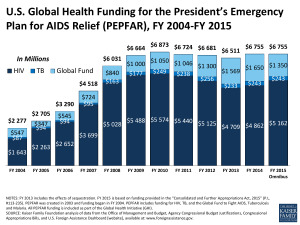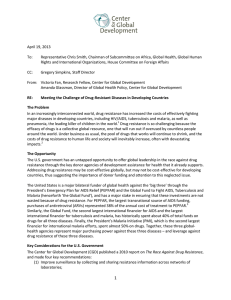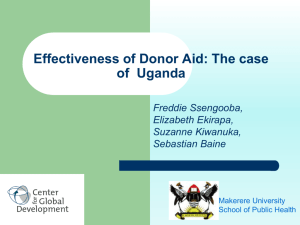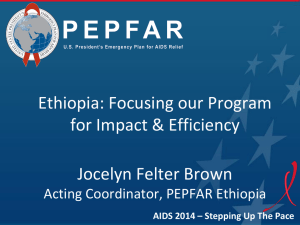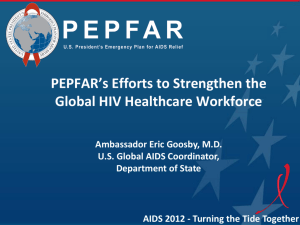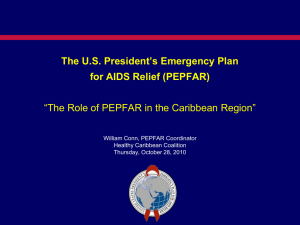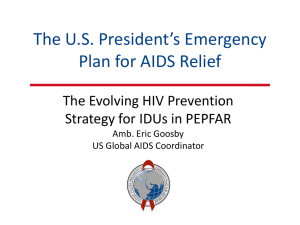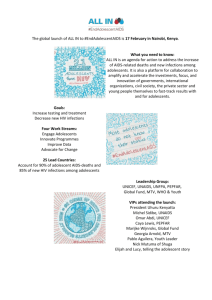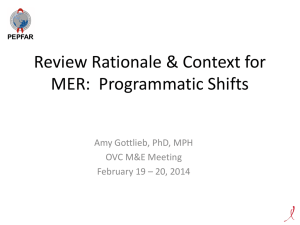The Financial Flows of PEPFAR: A Profile Victoria Fan, Rachel Silverman, Denizhan
advertisement
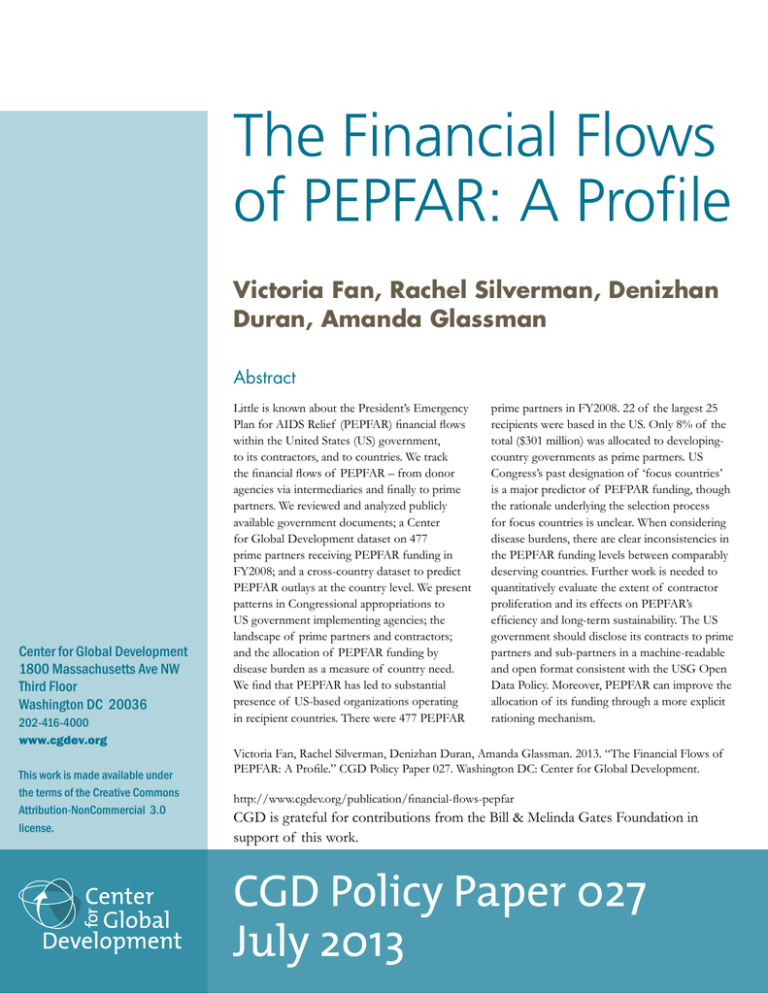
The Financial Flows of PEPFAR: A Profile Victoria Fan, Rachel Silverman, Denizhan Duran, Amanda Glassman Abstract Center for Global Development 1800 Massachusetts Ave NW Third Floor Washington DC 20036 202-416-4000 www.cgdev.org This work is made available under the terms of the Creative Commons Attribution-NonCommercial 3.0 license. Little is known about the President’s Emergency Plan for AIDS Relief (PEPFAR) financial flows within the United States (US) government, to its contractors, and to countries. We track the financial flows of PEPFAR – from donor agencies via intermediaries and finally to prime partners. We reviewed and analyzed publicly available government documents; a Center for Global Development dataset on 477 prime partners receiving PEPFAR funding in FY2008; and a cross-country dataset to predict PEPFAR outlays at the country level. We present patterns in Congressional appropriations to US government implementing agencies; the landscape of prime partners and contractors; and the allocation of PEPFAR funding by disease burden as a measure of country need. We find that PEPFAR has led to substantial presence of US-based organizations operating in recipient countries. There were 477 PEPFAR prime partners in FY2008. 22 of the largest 25 recipients were based in the US. Only 8% of the total ($301 million) was allocated to developingcountry governments as prime partners. US Congress’s past designation of ‘focus countries’ is a major predictor of PEFPAR funding, though the rationale underlying the selection process for focus countries is unclear. When considering disease burdens, there are clear inconsistencies in the PEPFAR funding levels between comparably deserving countries. Further work is needed to quantitatively evaluate the extent of contractor proliferation and its effects on PEPFAR’s efficiency and long-term sustainability. The US government should disclose its contracts to prime partners and sub-partners in a machine-readable and open format consistent with the USG Open Data Policy. Moreover, PEPFAR can improve the allocation of its funding through a more explicit rationing mechanism. Victoria Fan, Rachel Silverman, Denizhan Duran, Amanda Glassman. 2013. “The Financial Flows of PEPFAR: A Profile.” CGD Policy Paper 027. Washington DC: Center for Global Development. http://www.cgdev.org/publication/financial-flows-pepfar CGD is grateful for contributions from the Bill & Melinda Gates Foundation in support of this work. CGD Policy Paper 027 July 2013 Contents Introduction ...................................................................................................................................... 1 Background and Literature Review ............................................................................................... 1 Data and methods ............................................................................................................................ 3 Results ................................................................................................................................................ 5 PEPFAR’s prime partners: profile and analysis ...................................................................... 7 Allocations across countries ..................................................................................................... 10 Discussion ....................................................................................................................................... 15 Appendix ......................................................................................................................................... 21 References for Appendix .............................................................................................................. 26 Introduction Acquired Immunodeficiency Syndrome (AIDS) has been a major donor priority for international assistance in the first decade of the twenty-first century, as evidenced by the creation of the Global Fund to Fight AIDS, Tuberculosis, and Malaria (the Global Fund) in 2002, followed by the US President’s Emergency Plan for AIDS Relief (PEPFAR) in 2003. According to recent estimates, AIDS accounted for US$7.6 billion or 30.5% of all development assistance for health (US$24.9 billion) in 2009 (Institute for Health Metrics and Evaluation 2006; UNAIDS 2010a). The US government (USG) is notable as the largest donor in AIDS, accounting for about $46 billion in Congressional allocations between FY2004 and FY2012 (OGAC 2013). These investments are large both in absolute and relative terms: international assistance for health accounted for as much as 58% of total AIDS funding spent in a sample of 36 sub-Saharan countries (UNAIDS 2012). Yet despite the magnitude of donor investments in AIDS, details on the allocation, stewardship, and end use of such funds remain largely outside of the public domain, particularly for PEPFAR. From this point forward, we refer to sum of those characteristics as the ‘financial flows’ of AIDS investments. This paper seeks to profile and analyze the financial flows of PEPFAR, which hitherto have not been systematically examined. We track the distribution of PEPFAR resources – from donor agencies, through intermediaries, and finally to countries – by manually reviewing and compiling publicly available government documents. First, we present trends and patterns in Congressional appropriations to USG implementing agencies. Next, the paper identifies PEPFAR’s 477 contractors and grantees (i.e. ‘prime partners’) for FY2008, and provides their corresponding PEPFAR funding using a new Center for Global Development (CGD) dataset. Finally, we explore allocation of funding by country need and programmatic area, and discuss implications of our findings for donor transparency and allocative efficiency. Through this profile, we hope to provide insight into the distribution and utilization of PEPFAR resources – a prerequisite (but not sufficient) input for any evaluation of PEPFAR’s aggregate impact across countries. A better understanding of financial flows can also help to inform assessments of ‘value for money’ in global health funding, particularly regarding both technical and allocative efficiency (Fan and Glassman 2012). Whereas ‘value’ refers to the benefits generated by AIDS funding, this profile of financial flows helps illuminate the monetary inputs to ‘value’ creation, i.e. the denominator in the ‘value for money’ agenda. Background and Literature Review There is limited information in the public domain on how PEPFAR funding is spent, and, consequently, the effectiveness and efficiency of that spending (Biesma et al. 2009; Oomman et al. 2008). Historically, PEPFAR has made public only very limited data on the unit costs or cost-effectiveness of its programs, specifically two reports on the cost of ARV treatment (OGAC 2010; OGAC 2012a) and a related journal article (Menzies et al. 2011). Most 1 recently, PEPFAR has published preliminary findings from its Expenditure Analysis Initiative (OGAC 2012b), which connects expenditure data to outputs in order to “determine the expenditure per beneficiary reached for a wide variety of services” (Holmes et al. 2012). However, the pilot report is limited in scope and does not include the underlying data, but instead “provides a curated sample” of findings, “which makes it difficult to draw any concrete conclusions from the data” (Fan et al. 2012b). To circumvent these data limitations, recent work has used Demographic and Health Survey (DHS) data to demonstrate a relationship between selection as a PEPFAR ‘focus country’ and subsequent declines in adult all-cause mortality (Bendavid et al. 2012). However, a 2009 evidence review found that much of the existing research was derived from a rich and highly contextualized body of descriptive and qualitative research; in contrast, there was a paucity of analytical research and rigorous program evaluations (Biesma et al. 2009), which would require greater access to PEPFAR data. While the evidence base has expanded in the interim, there remains limited robust quantitative evidence on the macro-level effects of PEPFAR’s implementation model. A 2012 study on Rwanda by Shepard et al. found that the scale-up of HIV/AIDS services did not negatively affect provision of nine unrelated health services at the facility level; however, the study suffered from substantial methodological weaknesses (Fan et al. 2012a). Most recently, two journals (JAIDS 2012; Health Affairs 2012) issued special thematic issues on PEPFAR to coincide with the July 2012 International AIDS Conference. As with prior work, the articles within these issues offer largely qualitative insight on the relationship between PEPFAR or AIDS funding more generally, and relevant outcomes on health systems. Among the few relevant quantitative findings within the issues, Grépin (2012) suggests that AIDS financing may have negatively affected childhood vaccination in recipient countries, though with potential positive spillovers for prenatal care in some settings. Likewise, Kruk et al. (2012) find an association between the “intensity” of a health facility’s AIDS program and deliveries at the facility among HIV negative women; however, the “convenience sample” is limited to those facilities offering PEPFAR-funded AIDS services supported by a single implementing partner, and thus does not offer an externally valid control group. It is also notable that most of the available evidence assesses the results of HIV financing more generally rather than of PEPFAR programs specifically, which may be in part be attributable to the lack of data availability and, consequently, the difficulty of extracting and isolating PEPFAR’s effects from those of other donors. At the time of most writing and analysis (2012), there were only two reports (to our knowledge) which provided, at best, a basic description of PEPFAR’s financial flows. An Institute of Medicine (IOM) report on PEPFAR presented a few characteristics of PEPFAR’s contractors without reference to funding levels (Committee on Planning 2010). Similarly, a 2008 report from the Center for Global Development (CGD) used older data (FY2004-06) with limited analysis (Oomman et al. 2008). 2 More recently (February 2013), the IOM released its second evaluation of PEPFAR, which contains an extensive discussion of PEPFAR’s appropriations, contracting arrangements, and resource allocation, including a profile of its prime- and sub- implementing partners and analysis of cross-country allocations. Though the IOM’s congressional mandate enabled unfettered access to internal data sources, the report’s authors nonetheless repeatedly expressed their frustration with data limitations. For example: ‘The committee wanted to explore funding to prime partners and sub-partners in order to understand the different kinds of actors that have been responsible for implementing PEPFAR services and activities over time. However, the committee’s analysis was limited by the unavailability of quality data. [The Office of the Global AIDS Coordinator] has not consistently tracked funding to prime partners across the whole of the program…In addition, USG agencies and PEPFAR mission teams are not required to report sub-partner funding to OGAC, so the committee was unable to examine funding flows through the sub-partner level’ (Committee on the Outcomes 2013). In the absence of comprehensive data sources on PEPFAR’s financial flows, the IOM cobbled together several different data sources to inform its analysis. To examine funding by implementing partner, the IOM extracted data from publicly available documents (including a dataset by the Center for Global Development, 2008) for a sample of 13 countries. By focusing on a ‘subset of partner countries,’ the IOM was able to narrow its scope and assess trends (up until FY2010). However, the IOM report does not disclose the identity of the countries, the implementing partners, or the magnitude of their allocations; further, the analysis is not necessarily a representative sample of the entire PEPFAR portfolio (Committee on the Outcomes 2013). In contrast, our profile of prime partners (methodology discussed further below) is (1) comprehensive for a single year of funding (FY2008); (2) discloses the identity of prime partners, funding amounts, and country characteristics; and (3) is accompanied by a public dataset to enable further analysis by outside stakeholders. The findings in this paper can thus be seen as complementary to those reported in the IOM report. Data and methods Our analysis is organized into three main parts: (1) a profile of funding flows from Congress to implementing government agencies; (2) a detailed analysis of PEPFAR’s ‘prime partners, i.e. contractors, and (3) an analysis of PEPFAR’s funding allocations across countries. 3 The first part of our study involved the following data sources: the PEPFAR website; quarterly Obligation and Outlay Reports;1 and other secondary reports and official documentation (108th Congress of the United States 2003; 110th Congress of the United States 2008; Henry J. Kaiser Family Foundation 2008). For the second part, we analyze a unique CGD dataset of planned and approved bilateral funding transactions for PEPFAR in FY2008,2 which was compiled from individual Country Operational Plans (COPs).3 This CGD dataset records each planned contract between the partner and implementing agency and has four main variables: the planned funding for FY2008; the prime partner; the implementing agency; and the country. Funding flows reported through the COPS totaled $3.56 billion in FY2008, whereas the total amount approved for PEPFAR country activities was $3.60 billion (see appendix table 1). This suggests that our dataset represents the vast majority of PEPFAR’s country funding for FY2008. It also reveals that PEPFAR support to international partners such as the Global Fund represented a smaller proportion of total spending for the same year. For the third part, we analyze the predictors of cumulative PEPFAR outlays over FY2004-11 at the country level, with the goal of exploring the rationale behind historical PEPFAR allocations. Reliable time-series data of annual outlays was not available.4 Nevertheless, using cumulative outlays can be seen as more amenable to accounting for overall predictors over eight years, particularly if policymakers compensate over time to optimize allocations across countries. The main variables of interest are the burden of HIV cases in 2002 (UNAIDS 2010b), Congressional designation as a focus country in 2003 (Office of the Global AIDS Coordinator, ‘PEPFAR country profiles’), cumulative AIDS funding from the Global Fund (2003-11, Global Fund 2012b), a measure of government effectiveness for 2002 (Kaufman et al. 2006), and GDP per capita for 2002 (International Monetary Fund 2012). Our explanatory variables use data from 2002 in order to avoid post-treatment bias and potential endogeneity (King 2010). 1 While the quarterly Obligation and Outlay Reports were a valuable source for this analysis, they should be treated with some caution due to apparent errors in their compilation – for example, misaligned columns and country names in the December 2010 report (which are obvious when compared to previous reports for the same countries). The authors have attempted to correct any such errors and reflect accurate information, but may have missed less obvious discrepancies. 2 The dataset used to inform this analysis was compiled under the leadership of Nandini Oomman, with assistance from Steve Rosenzweig, Christina Droggitis, Preeti Dhillon, Jonathan Pearson, and Rachel Silverman. The authors are grateful for their contributions to the dataset, without which this analysis would not be possible. 3 COPs are PEPFAR-specific documents prepared according to guidance provided by OGAC; each COP is drafted through a country-level interagency planning process and led by the relevant US Ambassador. Planned and approved funding has been allocated by implementing agencies through this planning process and approved by OGAC. 4 A crude approximation of time-series outlay data can be compiled through manipulation of the quarterly Obligation and Outlay Reports, wherein annual outlays are calculated as the difference between cumulative outlays for each fiscal year. However, our attempt to compile such data revealed significant several errors and inconsistencies, making us wary of overreliance on this data source. 4 Results Trends and patterns in appropriations and obligations Formed in 2003, PEPFAR quickly grew to represent a majority of US global health funding with a budget of $6.9 billion in FY2010; since then, funding levels have stagnated due to an increasingly austere budget climate (Figure 1). Figure 1: Congressional Allocations to PEPFAR Over Time (USD Millions) 8,000 7,000 6,000 Bilateral TB Programs 5,000 Global Fund 4,000 3,000 Bilateral HIV/AIDS Programs 2,000 1,000 0 Source: OGAC 2013 Notes: Funding for FY2013 and FY2014 are budget requests; all other figures represent enacted amounts. Box 1 presents an overview of the program’s history and structure. PEPFAR funding is appropriated by the US Congress through a number of line items and accounts to four different government agencies. About 78% of appropriations go directly to the Office of the Global AIDS Coordinator (OGAC) for distribution, with the remaining 22% appropriated directly to other implementing government agencies such as USAID and the Department of Health and Human Services (HHS). However, these agencies also receive additional funding through OGAC.5 5 Direct appropriations to agencies appear to be a legacy of the pre-PEPFAR period, when all AIDS funding went directly to agencies rather than through OGAC. Moreover, funding directly appropriated to USAID tends to be allocated to smaller country programs that do not receive OGAC funding. Notwithstanding its source, all PEPFAR is reported through interagency coordinating mechanisms and requires OGAC’s approval. 5 Box 1. Origins and overview of PEPFAR. Phase 1 (2003-2008). Launched under President George W. Bush in 2003 with broad bipartisan support, the President’s Emergency Plan for AIDS Relief (PEPFAR) is ‘the US government initiative to help save the lives of those suffering from HIV/AIDS around the world’ (AIDS.gov, ‘PEPFAR). PEPFAR was created by the ‘US Leadership Against AIDS, Tuberculosis and Malaria Act of 2003’ (P.L. 108-25), which authorized up to $15 billion over 5 years to fund HIV treatment and prevention programs in developing countries. The bill also created an Office of the Global AIDS Coordinator (OGAC) within the State Department to coordinate and oversee bilateral U.S. investments in the fight against AIDS (Sessions 2006). The administration is required under the law to report its PEPFAR activities to the ‘appropriate congressional committees,’ including the House Foreign Affairs Committee and the Senate Foreign Relations Committee (108th Congress of the United States 2003). Phase 2 (2008-2013). At the conclusion of its first authorization, Congress reauthorized PEPFAR for another 5 years through the ‘Tom Lantos and Henry J. Hyde United States Global Leadership Against HIV/AIDS, Tuberculosis, and Malaria Reauthorization Act of 2008’ (OGAC, ‘A commitment renewed’). The bill authorized $48 billion over a five year period, representing a significant increase in US funding for HIV/AIDS and related global health priorities. Of that amount, $39 billion was earmarked for HIV/AIDS under PEPFAR; $5 billion for the President’s Malaria Initiative; and $3 billion for bilateral tuberculosis programs (OGAC, ‘A commitment renewed’). Under the reauthorization, PEPFAR’s funding priorities were amended as follows: (1) At least 10% of funds must be spent on programs to assist orphans and vulnerable children (OVC); (2) At least 50% of bilateral funding (i.e. PEPFAR funding excluding the Global Fund contribution) must go towards AIDS care and treatment; (3) A ‘balanced’ distribution of prevention funding is expected, wherein a report must be submitted to Congress if programs promoting abstinence, delay of sexual debut, monogamy, fidelity, and partner reduction make up less than half of PEPFAR’s total prevention portfolio in any target country with a generalized epidemic (Henry J. Kaiser Family Foundation 2008). After funding from Congress is appropriated to OGAC, OGAC allocates funding to an implementing agency, which then obligates the funding, i.e., legally commits the funding for disbursement. Over FY2004-FY2011, $27.9 billion dollars of PEPFAR funding were obligated by six different agencies (see appendix table 2), with 56.1% obligated by USAID and 38.3% by HHS (mainly the Centers for Disease Control and Prevention (CDC), the Health Resources and Services Administration (HRSA), and the National Institutes of Health (NIH)) (AVERT, ‘PEPFAR’). The smaller agencies fund specialized programs in their areas of expertise, e.g. the Department of Labor focuses on ‘workplace-targeted’ 6 HIV/AIDS projects (OGAC, ‘Implementing agencies’). Whereas congressional appropriations to OGAC in the Department of State accounted for as much as 78% of total PEPFAR funding, most was re-distributed to implementing agencies with 2.5% of obligated funding remaining in the Department of State. Thus funding essentially passes through OGAC, which allocates funding to recipient countries and coordinates the funding across different implementing agencies. In addition to funding obligated by implementing agencies, the USG also contributed $7.4 billion to the Global Fund between FY2004 and FY2012 (OGAC 2013), or about 29% of global contributions to the Global Fund over the same period (given legislation that caps US contribution to 33% of total contributions (Global Fund 2013). Spending on the Global Fund accounted for 17% of total PEPFAR HIV/AIDS spending for FY2008 (appendix table 1). Funding obligated by implementing government agencies is then distributed across a range of programmatic areas (appendix figure 1) to implementing partners, who essentially serve as government contractors (see appendix figure 2 for a diagram of funding flows). ‘Prime partners’ receive PEPFAR monies directly from implementing government agencies, and may have one or more ‘sub-partners,’ which in turn receive funds from the prime partners and do not have a direct contractual relationship with the USG (OGAC, ‘Partners’). PEPFAR’s prime partners: profile and analysis In total, 477 organizations were identified and recorded as having been approved for PEPFAR funding in FY2008; there are almost certainly even more local organizations that received funding through sub-grants or sub-contracts. Total funding for FY2008 ranged between a high of $310.2 million for the Partnership for Supply Chain Management (which helps manage the international supply chain for ARV drugs and other treatment and prevention commodities), to a low of $6,300 to Kula (a Mozambique-based consulting firm). The average organization received a reported $7.5 million dollars and the median amount received was $1.5 million. There are two obvious limitations of the data. First, the dataset is limited to prime partners, and thus does not include information on PEPFAR’s many subgrantees. This has several important implications; for example, it is not known what percentage of PEPFAR funding is ultimately provided to country governments or local organizations, either in cash or in kind, since money from prime partners can be redistributed to governments or local NGOs as sub-partners (i.e. sub-contractors), and both prime partners and non-governmental subpartners may operate programs within public facilities. Second, the data presented here are from FY2008. Although information for more recent years is publicly available, such data is not in a format that is easily extracted, cleaned, or analyzed. Thus, our data analysis can be interpreted as a baseline study from which data from later years can be compared, and as a complement to the information with fewer countries but with more years, provided in the IOM report (Committee on the Outcomes 2013). 7 Table 1 presents the 25 largest implementing partners in terms of FY2008 funding, which includes three US agencies.6 The top 25 recipients accounted for $2.05 billion in approved funding. Put differently, the largest 5% of recipients accounted for 58% of the total funding for all recipients. Among the top 25 recipients, all but three (shaded in red) are based in the US, and all but one of the US organizations are based on the east coast. Six of the top 25 recipients are major American universities. Further down the list is a broad range of recipient organizations, including an array of local organizations, recipient government ministries, faith-based organizations, and for-profit consulting companies. Among the lowest 25 recipients (not shown), nearly all were local partners. Table 1. Planned Funding by Top 25 Recipient Organizations (Millions), FY2008. Elizabeth Glaser Pediatric AIDS Foundation Amount Institutio Countries Received n Type Non310.23 15 profit Non203.90 20 profit 164.71 30 USG Non159.65 12 profit Non112.76 11 profit USAID 97.62 31 Columbia University Mailman School of Public Health 81.26 5 Management Sciences for Health 79.47 13 Harvard University School of Public Health 78.06 3 Academic Boston, MA, USA Population Services International 72.10 20 Nonprofit Columbia University 58.49 4 Academic University of Maryland 58.33 1 Academic John Snow, Inc. University of Washington 58.07 52.79 18 12 Pact, Inc. 50.45 14 For-profit Academic Nonprofit Recipient Partnership for Supply Chain Management Family Health International US CDC Catholic Relief Services 6 Headquarters Arlington, VA, USA Durham, NC, USA Atlanta, GA Baltimore, MD, USA Washington, DC, USA Washington, DC, USG USA New York, NY, Academic USA NonCambridge, MA, profit USA Washington, DC, USA New York, NY, USA College Park, MD, USA Boston, MA, USA Seattle, WA, USA Washington, DC, USA While true ‘implementation’ is rarely done by USG agencies, we include their country-level operating expenses herein to provides a sense of scale of their role relative to contractors and grantees. In some cases, as with CDC support to country counterparts, USG staff may take more proactive roles in the provision of technical assistance. 8 Amount Institutio Countries Received n Type NonJHPIEGO 48.81 10 profit NonAcademy for Educational Development 47.05 15 profit Department of State Regional 38.96 7 USG Procurement Support Office/Frankfurt NonKenya Medical Research Institute 38.82 2 profit NonIntraHealth International, Inc. 38.67 11 profit NonRight To Care, South Africa 37.70 1 profit Johns Hopkins University Center for 36.79 7 Academic Communication Programs Recipient Deloitte Consulting Limited 35.63 2 Pathfinder International 33.20 6 Foundation for Professional Development 29.32 1 Headquarters Baltimore, MD, USA Washington, DC, USA Washington, DC, USA Nairobi, Kenya Chapel Hill, NC, USA Johannesburg, South Africa Baltimore, MD, USA New York, NY, For-profit USA NonWatertown, MA, profit USA NonPretoria, South profit Africa Notes: In this dataset there were 31 country recipients and 1 ‘regional’ recipient (i.e. Caribbean); in addition, USG agencies are operating in other countries where funding is channeled regionally or through direct appropriations and hence not recorded by OGAC. Partnership for Supply Chain Management is a coordinating organization for 13 member organizations and companies Academy for Educational Development is now dissolved and acquired by FHI 360. JHPIEGO is an affiliate of Johns Hopkins University. In addition, $40.8 million was provided to an unspecified organization(s) in the Caribbean Region. The dominance of US organizations may be explained by several factors. First, large American NGOs have worked in multiple countries; accordingly, their aggregate funding will appear larger than that for any individual local government or NGO, which operates in only a single country. Unsurprisingly, most of the organizations with the largest number of country operations were also in the top 25 recipients. Second, larger NGOs (many of which are based in the US) can help achieve economies of scale; for example, the Partnership of Supply Chain Management is deliberately designed as a procurement monopoly for PEPFAR. Third, US contractors may be better equipped to comply with strict USG reporting requirements imposed by Congress, or may be seen as more competent and reliable than partner country governments or NGOs. This factor may have held even greater significance in PEPFAR’s early years, when high-capacity US organizations were seen as necessary to achieve rapid scale-up. Finally, the disproportionate selection of American implementers may have also been driven by political considerations and influence, including the desire to fund American jobs and the ability of contractors based in Washington, DC to lobby or conduct outreach, both in Congress and within OGAC. In the dataset, each prime partner was categorized based on its name as an academic, local government, NGO, USG, multilateral, or bilateral (non-US) institution. Funding given to 9 local governments is relatively small compared to US academic institutions or NGOs; however, it is important to note that governments often receive substantial support through the Global Fund, which is partially financed by US contributions. Universities or research institutes received $686 million, or about 19% of total reported funding. By contrast, $301 million in planned funding was allocated to developing-country governments as prime partners. This represents only 8% of the total. Table 2 compares USG implementing agencies in terms of the number and types of prime partners. Not surprisingly, both USAID and the US CDC had many prime partners. However, the CDC had a larger percentage of local government partners (28%) than USAID (5%). Table 2. Number of recipients of planned PEPFAR funding by implementing agency, FY2008. Agency USAID HHS DoD DoS Peace Corps DoL Amount ($, mil) 1,810.04 1,543.71 85.97 55.11 20.84 1.28 Median contract ($, mil) 1.10 1.04 0.58 0.62 1.07 0.20 No. of partners 221 262 33 10 1 1 No. of countries 32 30 23 20 16 5 Ratio of partners to country 6.9 8.7 1.4 0.5 0.1 0.2 Academic 22 57 5 1 0 0 Notes: In addition, there were 3 contracts whose agency was designated as ‘PEPFAR’ (which totaled $43.0 million) and hence not included in this table. The median contract size refers to the median number of set of 1115 partners working in countries for each agency, of which 477 are unique. Generally, the countries which received more money also had more prime partners (Pearson correlation coefficient 0.9940). South Africa had the highest number of prime partners (131), followed by Tanzania (85), and Kenya (74) (see appendix table 4). Allocations across countries In FY2009, PEPFAR provided bilateral or regional funding to 88 countries on five continents, of which 15 were originally categorized as ‘focus countries’ (OGAC, ‘PEPFAR bilateral countries’). Focus countries were designated by Congress at PEPFAR’s passage in 2003 to receive concentrated US investment; Vietnam was formally added as the 15th and final focus country in the 2008 reauthorization. PEPFAR focus countries accounted for 90% of obligated bilateral OGAC funding for country activities, which totaled 19.8 billion over FY2004-11 (see appendix table 4). Funding is concentrated in Sub-Saharan Africa, particularly the high-prevalence, high-population countries of South Africa, Kenya, Nigeria, Ethiopia, Uganda, Tanzania, Zambia, and Mozambique, which have each received over one billion dollars since 2004. 10 Local gov’t 12 73 12 1 0 0 As was also noted in the 2013 IOM report, PEPFAR’s funding priorities are correlated but not entirely aligned with the distribution of the global disease burden, as defined both by the absolute number of HIV cases and national prevalence rates (see Figure 2). Three focus countries (Rwanda, Haiti, Guyana) do not rank within the top 30 for number of HIV cases, although they have moderate prevalence rates due to their small populations. For Haiti and Guyana, proximity to the United States and longstanding aid relationships may also help explain the disproportionately large attention. Still, Haiti, Rwanda, Namibia, and Swaziland all have roughly the same number of HIV cases; of these four countries, Swaziland has the highest HIV prevalence rate, yet receives the least amount of money. Cumulative PEPFAR outlays totaled $635 million in Rwanda, compared to $126 million in Swaziland (appendix table 4). Figure 2. Total number of HIV cases vs. HIV adult prevalence rate across countries, 2009. Sources: UNAIDS 2010a; Central Intelligence Agency, ‘Country comparison: HIV/AIDS adult prevalence rate.’ Note: 3-digit codes here refer to the International Organization for Standardization (ISO) 3166-1 alpha-3 standard. Several countries receive little PEPFAR funding relative to their high disease burdens alone (not accounting for income levels), particularly India, Zimbabwe, Russia, and Malawi. India has an enormous population relative to its disease burden, creating a low prevalence rate 11 despite its high absolute number of infections. This, along with its middle-income status, may help explain the relatively low amount of funding it received under PEPFAR. Likewise, Russia is a large country with a low overall prevalence rate, relatively high income, and a strained geopolitical relationship with the United States. In Zimbabwe, deteriorating governance under the Mugabe regime and dangerous operating conditions for US organizations are likely to be explanatory factors. However, the reasons for Malawi’s exclusion are not apparent, as it has (1) a democratic, pro-Western government; (2) a high HIV prevalence rate; and (3) extremely low levels of human development, although there have been recent concerns about corruption of Global Fund support in the country (Central Intelligence Agency, ‘The world factbook: Malawi’; Global Fund observer 2011). In Asia, PEPFAR’s 2008 reauthorization bill designated Vietnam as a focus country. Vietnam has about as many cases and a much lower prevalence rate than Ghana. Yet Ghana was not designated as a focus country, and between FY2004 and FY2011 it received less than a fifth of the PEPFAR assistance given to Vietnam. In order to reach PEPFAR’s targets, funding may not necessarily be allocated based upon any single parameter described above, e.g. the total disease burden, prevalence rate, population, political stability, or geopolitical considerations. Next we explored and analyzed multiple predictors of cumulative PEPFAR outlays over FY2004-11 at the country level. Table 3 presents regression results of PEPFAR countries to analyze the predictors of cumulative PEPFAR funding over 2004-11. The results indicate that the two main predictors of PEPFAR funding are (1) the absolute number of adults aged 15 and older living with HIV and (2) having designation as a PEPFAR ‘focus country’. On average, each additional HIVinfected adult is associated with $413 in PEPFAR funding7; being designated by Congress as a ‘focus country’ is associated with $800 million in PEPFAR funding (columns 1 and 2, respectively). Together, these two variables alone explain as much as 82.6% of the variation observed across countries in cumulative PEPFAR funding, and suggest that PEPFAR allocations are largely based on these two factors, even after holding constant measures of government effectiveness and GDP per capita. It is also notable that additional regressions indicate that Global Fund disbursements, government effectiveness, and income (and accordingly a country’s level of health spending) are not associated with PEPFAR funding, which suggests that the Global Fund may be filling ‘gaps’ in PEPFAR funding. Results of similar regressions on a full sample of countries are comparable (appendix table 3). This approach to analyzing PEPFAR’s allocation is merely descriptive, and is not necessarily an endorsement of using those factors to determine allocations. For example, if PEPFAR uses US contractors to help build state capacity, then it may be reasonable for funding allocations to favor countries with weaker capacity. However, neither the US Congress nor PEPFAR have provided explicit criteria for funding allocation decisions, nor have they 7 This amount refers to the average spending over 2004-11. In addition, as coverage of ART of HIVinfected adults varies considerably (and is far less than 100%), actual expenditures per HIV-infected ART-eligible patient on ART is larger than this amount. 12 provided a rationale for how country selection will contribute to reaching global PEPFAR targets. If PEPFAR’s main goal is to save the largest number of lives, then it would imply a strategy of reaching countries with a larger number of HIV cases, though this strategy may not optimize global HIV/AIDS decline (Schwartlander et al. 2011). Given that initial designation as a focus country appears to have held great funding significance, and given ‘stickiness’ and institutional inertia in funding allocations, the lack of a clear rationale for such choices is surprising and requires further analysis for global allocative efficiency from PEPFAR’s perspective. 13 Table 3. PEPFAR Countries Only: Predictors of PEPFAR funding (millions), FY2004-11. Predictors (1) Pop’n aged 15+ living with HIV, 2002 (millions) 412.937*** (78.247) PEPFAR ‘Focus Country’ (2) (3) Observations R2 F-statistic (5) 333.731*** (54.412) 800.078*** (146.052) (6) (7) 443.068*** (60.114) (8) 393.275*** (36.791) 627.419*** (105.294) Global Fund funding in HIV, 2003-11 (millions) Governance indicator, 2002 GDP per capita, 2002 Constant (4) 590.536*** (92.626) 0.809* (0.401) -0.600 (0.894) -0.417 (0.533) 156.535 (177.182) -117.240 (98.613) 154.193** (58.080) 70.741*** (11.012) -83.338** (33.268) 278.006** (120.455) 238.671* (138.092) 528.333*** (141.445) -0.034 (0.118) 473.128*** (140.988) 30 0.524 27.85 36 0.551 30.01 30 0.826 95.18 33 0.053 4.078 30 0.539 27.16 33 0.025 0.781 32 0.003 0.0814 Notes: Standard errors in parentheses. Significance: *** p<0.01, ** p<0.05, * p<0.1. 14 -0.041 (0.054) -52.712 (137.692) 29 0.852 88.46 Discussion This study offers two main results in analyzing PEPFAR’s funding flows. First, using data on prime partners from FY2008, we provide and quantify the landscape of US contractors for PEPFAR in Phase 1. In particular, the latter finding confirms and quantifies the substantial presence of US-based organizations operating in recipient countries during Phase 1 of PEPFAR’s operations (pre-2009), which has been observed qualitatively in past studies. Second, it analyzes predictors of cumulative PEPFAR funding using cross-country analysis and finds few predictors other than number of HIV cases and the now-defunct designation of ‘focus country’. As of FY2008, the great majority of PEPFAR implementation occurred outside of public structures, led by international US-based organizations primarily selected through a competitive bidding process. This finding is also unsurprising, as proliferation of contractors was a stated goal of ‘Phase 1’ of PEPFAR, comprising part of a delivery strategy to reach scale by overcoming immediate country ‘capacity’ constraints in the face of what was seen as an emergency. In 2009, however, PEPFAR adopted a new 5-year strategy (‘Phase 2’), stating PEPFAR’s ambition to ‘transition from an emergency response to promotion of sustainable country programs,’ including through the transition of implementation responsibility to country governments (OGAC 2009). In 2011, the USG identified ‘working to increase the number and types of local partners…and strengthening the capacity of partner countries…’ as a core component (Quam 2011). These policy shifts between Phase 1 and Phase 2 are indicative of trade-offs between rapid scale-up and long-term sustainability. Hence, it is in the context of these policy changes in PEPFAR between Phase 1 and Phase 2, as well as the lack of evidence on PEPFAR’s impact on partner country capacity to date (Sepulveda et al. 2007), that our study can be seen as a baseline. In order to track basic trends in PEPFAR’s degree of partner proliferation and ‘country ownership’ – and to potentially identify their causal impacts on health outcomes of interest, data on PEPFAR’s contractors and sub-contractors over time are needed. Such future research can test empirically the USG’s stated commitment to transition implementation to country governments. Notably, the 2013 IOM evaluation suggests that little such movement occurred between FY2008 and FY2010 (the final year for which data was available). Indeed, in the IOM’s sample of 13 PEPFAR recipient countries, the percentage of funds going to partner country governments increased only one percentage point, from 8% to 9% of the total portfolio (Committee on the Outcomes 2013). We also find that the CDC has a higher percentage of government partners than USAID. The potential division of labor, specialization, and even competition between USG implementing agencies is an area for further attention and research. Further work should look at the relative cost-effectiveness of different implementing arrangements. As funding passes through multiple intermediaries (from Congress to OGAC to implementing agency to prime partner to sub-partner), each layer is likely to produce administrative transaction costs. 15 The costs and benefits of these intermediary transactions are unknown. For example, it is unclear whether academic institutions would have higher overhead rates when compared to other types of organizations, such as local NGOs or international for-profit contractors. In examining historical cross-country funding allocations over FY2004-11, we find enduring predictive power of the now-defunct designation of ‘focus country’ for current funding allocations. In part for this reason, we also identify several notable mismatches between country ‘need’ (as indicated by both income level and disease burden) and PEPFAR funding allocation, i.e. in Swaziland versus Rwanda, or Thailand versus Vietnam. Notably, even though OGAC no longer officially uses the designation ‘focus countries’, it is clear that the past designation from nearly a decade ago is still of major importance in predicting current allocations. Regardless of the initial reasons for focus country selection, the significance of focus-country designation for PEPFAR’s funding decisions is not surprising. There are likely to be economies of scale within a given country once activities begin; further, initial funding for an individual’s ARV treatment may create long-term or lifelong moral obligations to maintain treatment availability. Further work is needed to optimize HIV/AIDS funding across countries and across international donors in order to reach disease control goals efficiently and equitably. In conclusion, this study serves as another call for greater transparency and evaluation (Bouey and Padian 2011). The USG has committed to the International Aid Transparency Initiative (IATI) standards on transparency, which should be fully implemented for PEPFAR (IATI 2011). Moreover, the US government has recently announced an Open Data Policy, in which agencies are required to create information that is in a machinereadable and open format (OMB 2013). USG should henceforth disclose its contracts to both prime partners and sub-partners in a format consistent with IATI standards and the Open Data Policy. As the largest 5% of recipients accounted for 58% of total funding, simply requiring those 25 recipients to release their contracts (if not sub-contracts as well) would be a significant improvement from the status quo. US taxpayers have a right to access information on PEPFAR’s funding flows in a machine-readable and open format, without resorting to the Freedom of Information Act (FOIA) for each datum of information (or resorting to hiring full-time research assistance). The release of such data can help the public health and the development community to understand PEPFAR’s policy changes and their effects on health and health-care services in the countries it works in. As PEPFAR approaches its tenth birthday and Congressional reauthorization, further research is needed to empirically test PEPFAR’s success in meeting its own stated objectives, namely country ownership and increased efficiency of service delivery. 16 References 108th Congress of the United States of America. 2003. United States leadership against HIV/AIDS, tuberculosis, and malaria act of 2003. Public Law 108-25; 27 May 2003. 110th Congress of the United States. 2008. Tom Lantos and Henry J. Hyde United States global leadership against HIV/AIDS, tuberculosis, and malaria reauthorization act of 2008. Public Law 110-293; 30 July 2008. AIDS.gov. (n.d.). PEPFAR. Online at: http://aids.gov/federal-resources/around-theworld/pepfar/, accessed 16 March 2012. AVERT. (n.d.). President’s Emergency Plan for AIDS Relief (PEPFAR). Online at: http://www.avert.org/pepfar.htm, accessed 25 January 2012. Bendavid E, Holmes CB, Bhattacharya J, Miller G. 2012. HIV development assistance and adult mortality in Africa. JAMA 307(19):2060-2067. Biesma RG, Brugha R, Harmer A, Walsh A, Spicer N, Walt G. 2009. The effects of global health initiatives on country health systems: a review of the evidence from HIV/AIDS control. Health Policy Plan 24: 239-252. Bouey P, Padian N. 2011. PEPFAR-funding evaluations. Scientific Advisory Board Meeting. Presentation. 6 January 2011. Online at: http://www.pepfar.gov/documents/organization/154883.pdf, accessed 1 April 2012. Center for Global Development, 2008. Newly Available PEPFAR Data. http://www.cgdev.org/page/newly-available-pepfar-data Central Intelligence Agency. (n.d.). Country comparison: HIV/AIDS adult prevalence rate. CIA world factbook. Available: https://www.cia.gov/library/publications/the-worldfactbook/rankorder/2155rank.html. Accessed 16 March 2012. Central Intelligence Agency. (n.d.). The world factbook: Malawi. Online at: https://www.cia.gov/library/publications/the-world-factbook/geos/mi.html, accessed 16 March 2012. Committee on Planning the Assessment/Evaluation of Programs Implemented Under the U.S. Global Leadership Against HIV/AIDS, Tuberculosis, and Malaria Reauthorization Act of 2008. Strategic approach to the evaluation of programs implemented under the Tom Lantos and Henry J. Hyde U.S. global leadership against HIV/AIDS, tuberculosis, and malaria reauthorization act of 2008. 2010. Washington: Institute of Medicine and National Research Council of the National Academy of Sciences. Committee on the Outcome and Impact Evaluation of Global HIV/AIDS Programs Implemented Under the Lantos-Hyde Act of 2008. 2013. Evaluation of PEPFAR. Washington: Institute of Medicine of the National Academy of Sciences. Fan V, Glassman A. 2012. Value for money in global health: a framework for global health funding agencies. Washington: Center for Global Development. Unpublished draft. Fan V, Silverman R, Glassman A. 2012a. Does HIV/AIDS undermine health systems? Am J Trop Med Hyg 87(3): 579-580. Fan V, Silverman R, Glassman A. 2012b. Expenditure analysis: unlocking PEPFAR’s value for money potential? Global Health Policy Blog. Center for Global Development. 17 Accessed 12 February 2013 at http://blogs.cgdev.org/globalhealth/2012/08/expenditure-analysis-unlocking-pepfarsvalue-for-money-potential.php G8 Information Center. 2005. Africa. Gleneagles G-8 Summit Official Documents. Gleneagles: G-8. Online at: http://www.g8.utoronto.ca/summit/2005gleneagles/africa.html, accessed 11 May 2012. Global Fund Observer. 2011. NEWS: most OIG country audits result in fraud investigations. Issue 137. The Global Fund to Fight AIDS, Tuberculosis, and Malaria. 2013. Core pledges and contributions list. Online at: http://www.theglobalfund.org/documents/core/financial/Core_PledgesContributions _List_en/, accessed 2 July 2013. The Global Fund to Fight AIDS, Tuberculosis and Malaria. 2012b. Customized grant data report. Available: http://portfolio.theglobalfund.org/en/DataDownloads/CustomizeReportDownload, accessed 16 March 2012. Grépin K. 2012. HIV donor funding has both boosted and curbed the delivery of different non-HIV health services in sub-Saharan Africa. Health Affairs 31(7): 1406-1414. Health Affairs. 2012. Assessing the President’s Emergency Plan for AIDS Relief. Special issue. Health Affairs 31(7):1378-1598. The Henry J. Kaiser Family Foundation. 2008. Reauthorization of PEPFAR, the United States leadership against HIV/AIDS, tuberculosis and malaria act: a side-by-side comparison to current law. Washington: Kaiser. Holmes CB, Blandford JM, Sangrujee N, Stewart SR, DuBois A, et al. 2012. PEPFAR’s past and future efforts to cut costs, improve efficiency, and increase the impact of global HIV programs. Health Affairs 31(7): 1553-11560. Institute for Health Metrics & Evaluation. 2006. Financing global health 2010: development assistance and country spending in economic uncertainty. Seattle: IHME. International AID Transparency Initiative. 2011. IATI standards. Online at: http://www.aidtransparency.net/iati-standard, accessed 16 March 2012. International Monetary Fund. 2012. World economic outlook database. Online at: http://www.imf.org/external/pubs/ft/weo/2011/02/weodata/index.aspx, accessed 16 March 2012. Journal of Acquired Immune Deficiency Syndromes. 2012. The United States President’s Emergency Plan for AIDS Relief (PEPFAR): Its Vision, Achievements, and New Directions. Special issue. JAIDS 60(Supplement 3): S49-162. Kaufmann D, Kraay A, Mastruzzi M. 2006. Governance matters V: governance indicators for 1996-2005. Washington: World Bank. Online at: http://go.worldbank.org/X35TR3HIM0, accessed 16 March 2012. King G. 2010. A hard unsolved problem? Post-treatment bias in big social science questions. Presentation at Hard Problems in Social Science Symposium, Institute for Quantitative Social Science, Harvard University. 10 April 2010. 18 Kruk ME, Jakubowski A, Rabkin M, Elul B, Friedman M, El-Sadr W. 2012. PEPFAR programs linked to more deliveries in health facilities by African women who are not infected with HIV. Health Affairs 31(7): 1478-1488 Menzies NA, Berruti AA, Berzon R, Filler S, Ferris R, et al. 2011. The cost of providing comprehensive HIV treatment in PEPFAR-supported programs. AIDS 25(14): 1753-60. Office of the Global AIDS Coordinator. (n.d.). Implementing agencies: Department of Labor. Online at: http://www.pepfar.gov/agencies/c19400.htm, accessed 3 February 2012. Office of the Global AIDS Coordinator. (n.d.). Multilateral cooperation. Online at: http://www.pepfar.gov/coop/index.htm, accessed 16 March 2012. Office of the Global AIDS Coordinator. (n.d.). Partners. Online at: http://www.pepfar.gov/budget/partners/index.htm#three, accessed 16 March 2012. Office of the Global AIDS Coordinator. (n.d.). PEPFAR: a commitment renewed. Online at: http://www.pepfar.gov/press/107735.htm, accessed 16 March 2012. Office of the Global AIDS Coordinator. (n.d.). PEPFAR bilateral countries. Online at: http://www.pepfar.gov/countries/bilateral/index.htm, accessed 16 March 2012. Office of the Global AIDS Coordinator. (n.d.). PEPFAR country profiles. Online at: http://2006-2009.pepfar.gov/press/c19558.htm, accessed 16 March 2012. Office of the Global AIDS Coordinator. (2004-2011). PEPFAR obligation and outlay reports. Online at: http://www.pepfar.gov/about/c24880.htm, accessed 3 February 2012. Office of the Global AIDS Coordinator. 2006. Action today, a foundation for tomorrow: the President’s Plan for AIDS Relief. Second annual report to Congress. Washington: OGAC. Office of Management and Budget. 2013. Open data policy—managing information as an asset. Memorandum for the heads of executive departments and agencies. 9 May 2013. Office of the U.S. Global AIDS Coordinator. 2009. The President’s Emergency Plan for AIDS Relief: U.S. five-year global HIV/AIDS strategy, executive summary of PEPFAR’s strategy. Washington: OGAC. Online at: http://www.pepfar.gov/strategy/document/133244.htm, accessed 1 April 2012. Office of the U.S. Global AIDS Coordinator. 2010. Report to Congress on the costs of treatment in the President’s Emergency Plan for AIDS Relief (PEPFAR). Office of the U.S. Global AIDS Coordinator. 2012a. Report on the costs of treatment in the President’s Emergency Plan for AIDS Relief (PEPFAR). Office of the U.S. Global AIDS Coordinator. 2012b. Report on pilot expenditure analysis of PEPFAR programs in six countries. Office of the U.S. Global AIDS Coordinator. 2013. Working Toward an AIDS Free Generation: Latest PEPFAR Funding. Oomman N, Bernstein M, Rosenzweig S, Pearson J. 2008. The numbers behind the stories. PEPFAR funding for fiscal years 2004 to 2006. HIV/AIDS Monitor. Washington: Center for Global Development. 19 Quam L. 2011. The Global Health Initiative: maximizing investment in global health. U.S. Department of State eJournal USA 16: 12–15. Schwartländer B, Stover J, Hallett T, Atun R, Avila C, Gouws E, et al. 2011. Investment Framework Study Group. Towards an improved investment approach for an effective response to HIV/AIDS. Lancet 377: 2031–41. Sepulveda J, Carpenter C, Curran J. 2007. PEPFAR implementation: progress and promise. Washington: Institute of Medicine. Sessions, Myra. 2006. Overview of the President’s Emergency Plan for AIDS Relief (PEPFAR). Washington: Center for Global Development. Online at: http://www.cgdev.org/page/overview-president%E2%80%99s-emergency-plan-aidsrelief-pepfar, accessed 16 April 2013. Shepard DS, Zeng W, Amico P, Rwiyerka AK, Avila-Figueroa C. 2012. A controlled study of funding for human immunodeficiency virus/acquired immunodeficiency syndrome as resource capacity building in the health system in Rwanda. Am J Trop Med Hyg 86: 902907. UNAIDS. 2010a. HIV estimates with uncertainty bounds, 1990-2009. Online at: http://www.unaids.org/globalreport/documents/HIV_Estimates_GR2010_1990_2009 _en.xls, accessed 16 March 2012. UNAIDS. 2010b. Report on the global AIDS epidemic 2010. Online at: http://www.unaids.org/globalreport/documents/20101123_GlobalReport_full_en.pdf, accessed 30 March 2012. UNAIDS. 2012. AIDSinfo online database. Online at: http://www.aidsinfoonline.org/, accessed 4 June 2012. 20 Appendix Appendix Table 1. Planned PEPFAR HIV/AIDS Funding by Account and Activity (Millions), FY2008 [1]. Account and Activity Country Activities Central Programs Strategic Information/Evaluation Technical Oversight and Management International Partners State/ GHCS 3,539 433 11 99 580 HHS/GAP & NIH 59 295 All Accounts 3,598 433 11 99 875 Total Approved Programs 4,662 354 5,016 Notes: Figures include approved funding for all PEPFAR programs which are planned through the interagency process. Only the State/GHCS account is approved by OGAC; funding from other accounts is approved by the respective agencies. Headquarters operational plan figures include all funding which is planned at the headquarter level, either through OGAC, USAID, or HHS. Appendix Figure 1. Bilateral Planned PEPFAR Funding by Programmatic Areas (Millions), FY2010 [4]. Adult Treatment ARV Drugs Management and Operations Health Systems Strengthening Orphans and Vulnerable Children Adult Care and Support PMTCT Other Prevention Counselling and Testing Laboratory Strengthening Abstinence and Fidelity Strategic Information TB/HIV Pediatric Treatment Male Circumcision Blood Safety Pediatric Care and Support Injecting and Non-Injecting Drug Use Injection Safety $659.1 $371.0 $364.3 $330.7 $327.9 $325.2 $313.3 $267.9 $201.6 $190.9 $187.9 $170.4 $137.1 $105.4 $70.9 $53.5 $51.2 $23.8 $23.6 $0 $100 $200 $300 $400 $500 $600 Notes: Planned PEPFAR funding refers to approved funding in countries that prepare PEPFAR Country Operational Plans (COPs). 21 $700 Appendix Figure 2. PEPFAR Funding Flow Diagram UNAIDS OGAC (Department of State) United States Congress The Global Fund DoD USAID HHS Other State Dept. Agencies Peace Corps Prime Partners Sub-partner Sub-partner 22 Sub-partner Departmen t of Labor Appendix Table 2. PEPFAR funding (thousands), by data source. CGD dataset: FY2008 Approved Funding in COPs Mean Country FY2008 funding per Approved Partners partner (000s) (000s) South Africa 575,697 131 4,395 Nigeria 431,011 47 9,170 Kenya 386,433 74 5,222 Ethiopia 304,153 63 4,828 Tanzania 283,926 85 3,340 Zambia 249,984 65 3,846 Uganda 245,642 65 3,779 Mozambique 217,989 53 4,113 Rwanda 118,593 44 2,695 Côte D’Ivoire 115,995 32 3,625 Namibia 108,428 34 3,189 Haiti 94,951 37 2,566 Botswana 80,559 43 1,873 Vietnam 78,165 24 3,257 Caribbean Region 51,850 15 3,457 India 29,939 21 1,426 Zimbabwe 25,406 14 1,815 Guyana 23,841 29 822 Malawi 20,407 22 928 Swaziland 14,132 22 642 Lesotho 13,222 22 601 Cambodia 12,100 10 1,210 Russian Federation 11,968 16 748 Congo 11,028 15 735 China 9,562 8 1,195 Indonesia 7,901 4 1,975 Angola 6,964 8 871 Ghana 6,782 9 754 Dominican Republic 6,315 7 902 Thailand 6,020 6 1,003 Sudan 5,850 6 975 Ukraine 5,105 6 851 Central America Region n.a. n.a. n.a. Central Asia Region n.a. n.a. n.a. Burundi n.a. n.a. n.a. Cameroon n.a. n.a. n.a. TOTAL 3,559,918 1,037 3,433 FY2004-11 Obligations & Outlays [2] Median funding per partner (000s) Obligations Outlays (000s) (000s) 1,994 1,900 1,860 1,613 1,284 1,185 1,900 1,500 649 1,250 1,411 790 1,033 910 595 900 523 400 605 347 443 744 625 768 838 375 434 400 350 561 1,052 472 n.a. n.a. n.a. n.a. 2,846,985 1,991,049 2,566,505 1,457,975 1,481,550 1,299,543 1,643,572 1,180,575 635,185 502,647 548,288 618,400 455,982 419,049 109,194 207,580 227,524 133,904 264,735 126,440 125,983 130,746 80,338 136,208 58,325 78,425 69,541 81,837 73,616 47,088 57,547 48,267 67,640 25,488 25,378 15,855 2,067,128 1,625,354 1,583,180 1,001,547 1,083,495 1,006,492 1,228,358 807,885 507,417 414,395 411,059 490,153 374,199 340,652 71,230 177,715 180,811 120,962 162,993 81,375 66,345 120,978 69,527 90,573 53,947 51,922 50,157 50,712 44,222 43,913 43,527 39,448 49,681 11,421 17,208 7,847 1,075 19,838,964 14,547,828 Notes: Countries shaded in red are PEPFAR ‘focus countries’. Figures refer only to Country Activities. In this table total cumulative obligations to countries ($19.8 billion) is smaller than the corresponding amount in Table 2 ($27.9 billion) because it excludes headquarters costs, and small programs in countries which do not 23 prepare country operational plans. The 1,037 partners in the ‘total’ here are not unique partners; this total refers to the number of partners in each country. In addition, countries receiving PEPFAR funding directly appropriated to USAID, HHS, and DoD are not reported here, e.g. in FY2011 some PEPFAR funding directly appropriated to USAID went to programs in Benin, Burundi, Guinea, Burma, Laos, Papua New Guinea, the Philippines, Bangladesh, Nepal, and Pakistan, none of which received any funding channeled through OGAC [3]. 24 Appendix Table 3. Full Sample of Countries: Predictors of PEPFAR funding (millions), 2004-11. Predictors (1) Pop’n aged 15+ living with HIV (millions) PEPFAR Focus Country 473.570*** (79.396) (2) (3) 857.555*** (142.700) 317.551*** (56.323) 582.382*** (98.628) Global Fund funding in HIV, 2003-11 (millions) Government effectiveness, 2002 GDP per capita, 2002 Constant (4) (5) (6) (7) (8) 360.859*** (37.773) 582.915*** (106.283) -0.360 (0.346) -27.056 (22.063) -0.004 (0.006) -12.952 (21.551) 97 0.884 48.91 462.932*** (58.786) 1.598*** (0.378) 0.111 (0.654) 24.670 (50.666) 22.229 (14.055) 13.264*** (3.318) -22.912*** (5.021) Observations 100 127 100 R-squared 0.635 0.677 0.874 F-statistic 35.58 36.11 85.62 Notes: Standard errors in parentheses; *** p<0.01, ** p<0.05, * p<0.1 3.414 (16.931) 17.096 (35.469) 131.927*** (42.143) -0.036 (0.024) 164.624*** (44.237) 134 0.279 17.91 98 0.634 31.38 122 0.002 0.237 121 0.019 2.251 25 References for Appendix 1. Office of the Global AIDS Coordinator (2008) PEPFAR fiscal year 2008 operational plan June 2008. 2. Office of the Global AIDS Coordinator (2012) PEPFAR summary financial status as of September 30, 2011. Obligations are legal commitments to spend money. Outlays are money that has actually been spent on activities. Available: http://www.pepfar.gov/documents/organization/184791.pdf. Accessed 1 April 2012. 3. USAID (2011) Congressional budget justification: foreign assistance, Fiscal Year 2011. 4. Office of the Global AIDS Coordinator (2011) FY 2010 budgetary requirements summary. Fiscal year 2010 operational plan. Available: http://www.pepfar.gov/about/2010/150595.htm. Accessed 16 March 2012. 26
